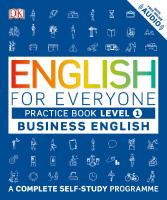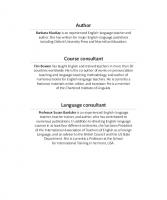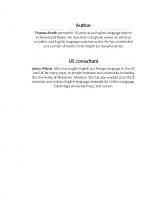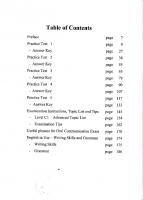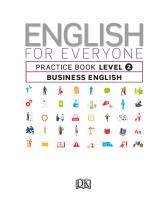English for Everyone: Business English Practice Book Level 2 9780241275153
PLEASE NOTE - this is a replica of the print book and you will need paper and a pencil to complete the exercises. Engli
837 200 83MB
English Pages [176] Year 2017
Contents
How the course works
01 Introductions
02 Getting to know colleagues
03 Vocabulary
04 Talking about changes
05 Delegating tasks
06 Vocabulary Money and finance
07 Writing a report
08 Making apologies
09 Vocabulary
10 Making plans by email
11 Keeping clients informed
12 Informal communication
13 Vocabulary Production
14 Describing a process
15 Describing a product
16 Vocabulary
17 Marketing a product
18 Advertising and branding
19 Advice and suggestions
20 Vocabulary
21 Talking about abilities
22 Comparing and contrasting
23 Planning events
24 Vocabulary Meetings
25 What people said
26 What people asked
27 Reporting quantities
28 Checking information
29 Vocabulary
30 Job descriptions
31 Applying for a job
32 Job interviews
33 Vocabulary Business idioms
34 Working relationships
35 Career outcomes
36 Vocabulary
37 Structuring a presentation
38 Developing an argument
39 Pitching a product
40 Talking about facts and figures
41 Plans and suggestions
42 Emphasizing your opinion
43 Discussing conditions
44 Discussing problems
Answers
Recommend Papers
File loading please wait...
Citation preview
Authors Thomas Booth worked for 10 years as an English-language teacher in Poland and Russia. He now lives in England, where he works as an editor and English-language materials writer, notably of course books and vocabulary textbooks. Trish Burrow worked for seven years as a teacher and teacher trainer in Poland and UK summer schools. After a year working in a UK college as an ELT lecturer, she worked as an editor of exams materials and then English-language teaching materials. She lives in the UK and is a freelance writer and editor.
Course consultant Tim Bowen has taught English and trained teachers in more than 30 countries worldwide. He is the co-author of works on pronunciation teaching and language-teaching methodology, and author of numerous books for English-language teachers. He is currently a freelance materials writer, editor, and translator. He is a member of the Chartered Institute of Linguists.
Language consultant Professor Susan Barduhn is an experienced English-language teacher, teacher trainer, and author, who has contributed to numerous publications. In addition to directing English-language courses in at least four different continents, she has been President of the International Association of Teachers of English as a Foreign Language, and an adviser to the British Council and the US State Department. She is currently a Professor at the School for International Training in Vermont, USA.
ENGLISH FO R E V E RYO N E PR ACTICE BOOK LEVEL BUSINESS ENGLISH
Contents Project Editors Lili Bryant, Laura Sandford Art Editors Chrissy Barnard, Paul Drislane, Michelle Staples Editor Ben Ffrancon Davies Editorial Assistants Sarah Edwards, Helen Leech Illustrators Edwood Burn, Michael Parkin, Gus Scott Managing Editor Daniel Mills Managing Art Editor Anna Hall Audio Recording Manager Christine Stroyan Jacket Designer Ira Sharma Jacket Editor Claire Gell Managing Jacket Editor Saloni Singh Jacket Design Development Manager Sophia MTT Producer, Pre-production Andy Hilliard Producer Mary Slater Publisher Andrew Macintyre Art Director Karen Self Publishing Director Jonathan Metcalf DK India Senior Managing Art Editor Arunesh Talapatra Senior Art Editor Chhaya Sajwan Art Editors Meenal Goel, Roshni Kapur Assistant Art Editor Rohit Dev Bhardwaj Illustrators Manish Bhatt, Arun Pottirayil, Sachin Tanwar, Mohd Zishan Editorial Coordinator Priyanka Sharma Pre-production Manager Balwant Singh Senior DTP Designers Harish Aggarwal, Vishal Bhatia DTP Designer Jaypal Chauhan First published in Great Britain in 2017 by Dorling Kindersley Limited 80 Strand, London, WC2R 0RL Copyright © 2017 Dorling Kindersley Limited A Penguin Random House Company 10 8 6 4 2 1 3 5 7 9 001–296906–Jan/2017 All rights reserved. No part of this publication may be reproduced, stored in or introduced into a retrieval system, or transmitted, in any form, or by any means (electronic, mechanical, photocopying, recording, or otherwise), without the prior written permission of the copyright owner. A CIP catalogue record for this book is available from the British Library. ISBN: 978-0-2412-7515-3 Printed and bound in China A WORLD OF IDEAS: SEE ALL THERE IS TO KNOW
www.dk.com
How the course works Introductions
8 12
New language Present simple and continuous Vocabulary Etiquette for introductions New skill Introducing yourself and others
Getting to know colleagues
16
New language Past simple and past continuous Vocabulary Sharing past experiences New skill Talking about past experiences
Vocabulary Departments and roles
20
Talking about changes
22
New language “Used to,” “be / get used to” Vocabulary Small talk New skill Talking about changes at work
Delegating tasks
26
New language Modal verbs for obligation Vocabulary Delegation and politeness New skill Delegating tasks to colleagues
Vocabulary Money and finance
30
Writing a report
32
New language Past perfect and past simple Vocabulary Formal business English New skill Writing reports
Making apologies
36
New language Present perfect continuous Vocabulary Apologies New skill Apologizing on the telephone
Describing a product
56
New language Adjective order Vocabulary Opinion and fact adjectives New skill Describing a product
Vocabulary Communication technology
40
Vocabulary Marketing and advertising
60
Making plans by email
42
Marketing a product
62
New language Email language Vocabulary Meetings and workshops New skill Making plans
Keeping clients informed
New language Adjectives and adverbs Vocabulary Descriptive adjectives New skill Modifying descriptions of products
44
New language Continuous tenses Vocabulary Arrangements and schedules New skill Keeping clients informed
Informal communication
65
New language Intensifiers Vocabulary “Enough,” too,” “so,” and “such” New skill Adding emphasis to descriptions
47
New language Phrasal verbs Vocabulary Arrangements and plans New skill Keeping co-workers informed
Advice and suggestions
68
New language Modal verbs for advice Vocabulary Workplace pressures New skill Giving advice
Vocabulary Production
50
Describing a process
52
New language The passive voice Vocabulary Processes and manufacturing New skill Discussing how things are done
Advertising and branding
Vocabulary Management, leadership, and skills
72
Talking about abilities
74
New language Modal verbs for abilities Vocabulary Workplace skills New skill Describing abilities
Comparing and contrasting
78
New language Discourse markers Vocabulary Teamwork and team building New skill Expressing your ideas
Planning events
82
New language Verb patterns Vocabulary Corporate entertainment New skill Talking about business events
86
What people said
88
New language Reported speech Vocabulary Meetings New skill Reporting what someone said
92
96
New language “Few,” “little,” and “all” Vocabulary Meetings New skill Talking about quantity
Checking information New language Subject questions, question tags Vocabulary Polite checks and echo questions New skill Checking information
Job descriptions
104
New language Articles Vocabulary Job descriptions and applications New skill Describing a job
107
New language Dependent prepositions Vocabulary Cover-letter vocabulary New skill Writing a cover letter
Job interviews
110
New language Relative clauses Vocabulary Job interviews New skill Describing your achievements in detail
New language Reported questions Vocabulary “Have,” “make,” “get,” “do” New skill Reporting what someone asked
Reporting quantities
102
Applying for a job
Vocabulary Meetings
What people asked
Vocabulary Industries and professional attributes
Vocabulary Business idioms
114
Working relationships
116
New language Three-word phrasal verbs Vocabulary Social media New skill Social networking
Career outcomes 99
120
New language Modal verbs for possibility Vocabulary Career development New skill Talking about the future
Vocabulary Office and presentation equipment
124
Structuring a presentation
126
New language Signposting language Vocabulary Presentation equipment New skill Structuring a presentation
Developing an argument
129
Answers
135
138
New language Indirect questions Vocabulary Business negotiations New skill Negotiating politely
Emphasizing your opinion New language Discourse markers for emphasis Vocabulary Workplace disagreement New skill Emphasizing your opinion
148
132
New language Collocations Vocabulary Business trends New skill Describing facts and figures
Plans and suggestions
Discussing problems New language Third conditional Vocabulary Workplace mistakes New skill Talking about past mistakes
New language Comparatives and superlatives Vocabulary Product marketing New skill Comparing products
Talking about facts and figures
144
New language Conditionals Vocabulary Negotiating and bargaining New skill Discussing possibilities
New language Useful presentation language Vocabulary Presentations New skill Developing an argument
Pitching a product
Discussing conditions
142
152
How the course works English for Everyone is designed for people who want to teach themselves the English language. The Business English edition covers essential English phrases and constructions for a wide range of common business scenarios. Unlike other courses, English for Everyone Job interviews uses images and graphics in all its learning and practice, to help you understand and remember as easily as possible. The best way to learn is to work through the book in order, making full use of the audio available on the website and app. Turn to the practice book at the end of each unit to reinforce your learning with additional exercises. In a job interview, it is important to describe your achievements in a specific and detailed way. You can use relative clauses to do this.
Job interviews In a job interview, it is important to describe your achievements in a specific and detailed way. You can use relative clauses to do this.
MATCH THE BEGINNINGS OF THE SENTENCES TO THE CORRECT ENDINGS New language Relative clauses Vocabulary Job interviews New skill Describing your achievements in detail
KEY LANGUAGE DEFINING RELATIVE CLAUSES Defining relative clauses give essential information that helps to identify a person or thing. Here, the defining relative clause gives essential information about a thing. MAIN CLAUSE
DEFINING RELATIVE CLAUSE
CROSS OUT THE INCORRECT WORDS IN EACH SENTENCE In defining relative clauses, this is the relative pronoun for things.
Here, the defining relative clause gives essential information about people. MAIN CLAUSE
DEFINING RELATIVE CLAUSE
REWRITE THE SENTENCES, CORRECTING THE ERRORS This relative pronoun is used for people.
New language Relative clauses Vocabulary Job interviews New skill Describing your achievements in detail
The defining relative clause can also go in the middle of the main clause.
CROSS OUT THE INCORRECT WORDS IN EACH SENTENCE
MAIN CLAUSE
DEFINING RELATIVE CLAUSE
RETURN TO MAIN CLAUSE
126
127
126-131_EFE_Business_B2_talking_about_your_experiences_unit32.indd 126
25/08/2016 16:55 126-131_EFE_Business_B2_talking_about_your_experiences_unit32.indd 127
LISTEN TO THE AUDIO, THEN NUMBER THE PICTURES IN THE ORDER THEY ARE DESCRIBED
COURSE BOOK 25/08/2016 16:55
MATCH THE BEGINNINGS OF THE SENTENCES TO THE CORRECT ENDINGS
110
110-113_Unit_32_Job_Interviews.indd 110
Unit number The book is divided into units. Each practice book unit tests the language taught in the course book unit with the same number.
111
26/08/2016 11:49 110-113_Unit_32_Job_Interviews.indd 111
PRACTICE BOOK
26/08/2016 11:49
Practice points Every unit begins with a summary of the key practice points.
Getting to know colleagues Talking about your past work experience is a good way to get to know your colleagues. Past simple and past continuous tenses are often used to do this.
MARK THE SENTENCES THAT ARE CORRECT
FILL IN THE GAPS BY PUTTING THE VER PERFECT SIMPLE
New language Past simple and past continuous Vocabulary Sharing past experiences New skill Talking about past experiences
LISTEN TO THE AUDIO, THEN NUMBER THE PICTURES IN THE ORDER THEY ARE DESCRIBED
Modules Each unit is broken down into modules, which should be done in order. You can take a break from learning after completing any module.
16
8
016-019_Unit_02_Getting_to_know_colleagues.indd 16
26/08/2016 15:14
016-019_Unit_02_Getting_to_know_colleagues.indd 17
Vocabulary Throughout the book, vocabulary pages test your memory of key business English words and phrases taught in the course book.
Visual practice Images act as visual cues to help fix the most useful and important English words and phrases in your memory.
Vocabulary COMMUNICATION TECHNOLOGY WRITE THE PHRASES FROM THE PANEL UNDER THE CORRECT DEFINITIONS
RBS IN THE PRESENT
40
41
040-041_Unit_09_Communication_Technology.indd 40
05/09/2016 14:13
040-041_Unit_09_Communication_Technology.indd 41
05/09/2016 14:13
Audio support Most modules have supporting audio recordings of native English speakers to help you improve your speaking and listening skills.
17
26/08/2016 11:48
FREE AUDIO website and app www.dkefe.com 9
Practice modules Each exercise is carefully graded to drill and test the language taught in the corresponding course book units. Working through the exercises alongside the course book will help you remember what you have learned and become more fluent. Every exercise is introduced with a symbol to indicate which skill is being practiced.
GRAMMAR Apply new language rules in different contexts.
VOCABULARY Cement your understanding of key vocabulary.
READING Examine target language in real-life English contexts.
SPEAKING Compare your spoken English to model audio recordings.
LISTENING Test your understanding of spoken English.
Module number Every module is identified with a unique number, so you can easily locate answers and related audio.
Exercise instruction Every exercise is introduced with a brief instruction, telling you what you need to do.
FILL IN THE GAPS BY PUTTING THE VERBS IN THE PRESENT PERFECT CONTINUOUS
Supporting graphics Visual cues are given to help you understand the exercises.
READ THE REPORT AND ANSWER THE QUESTIONS
Supporting audio This symbol shows that the answers to the exercise are available as audio tracks. Listen to them after completing the exercise.
Getting to know colleagues Talking about your past work experience is a good way
REWRITE THEwriting SENTENCES, PUTTING THE WORDS IN THE ORDER to getCORRECT to know your colleagues. Past simple and past Space for You are
encouraged to write your answers in the book for future reference. Sample answer The first question of each exercise is answered for you, to help make the task easy to understand.
continuous tenses are often used to do this.
ListeningMARK exercise This symbol THE SENTENCES THAT indicates thatARE youCORRECT should listen to an audio track in order to answer the questions in the exercise.
New language Past simple and past continuous Vocabulary Sharing past experiences New skill Talking about past experiences
LISTEN TO THE AUDIO, THEN NUMBER THE PICTURES IN THE ORDER THEY ARE DESCRIBED
CROSS OUT THE INCORRECT WORDS IN EACH SENTENCE, THEN SAY THE SENTENCES OUT LOUD
38
036-039_unit_08_making_Apologies.indd 38
26/08/2016 11:48
151
148-151_Unit_44_Discussing_problems.indd 151
Speaking exercise This symbol indicates that you should say your answers out loud, then compare them to model recordings included in your audio files.
26/08/2016 11:49
16
10 016-019_Unit_02_Getting_to_know_colleagues.indd 16
26/08/2016 15:14
Audio
Answers
English for Everyone features extensive supporting audio materials. You are encouraged to use them as much as you can, to improve your understanding of spoken English, and to make your own accent and pronunciation more natural. Each file can be played, paused, and repeated as often as you like, until you are confident you understand what has been said.
An answers section at the back of the book lists the correct answers for every exercise. Turn to these pages whenever you finish a module and compare your answers with the samples provided, to see how well you have understood each teaching point.
Answers Find the answers to every exercise printed at the back of the book.
LISTENING EXERCISES This symbol indicates that you should listen to an audio track in order to answer the questions in the exercise.
SUPPORTING AUDIO This symbol indicates that extra audio material is available for you to listen to after completing the module.
Exercise numbers Match these numbers to the unique identifier at the top-left corner of each exercise.
Audio This symbol indicates that the answers can also be listened to.
FREE AUDIO website and app www.dkefe.com 11
Introductions When you first join a company, there are many phrases that you can use to introduce yourself. Other people may also use a variety of phrases to introduce you.
New language Present simple and continuous Vocabulary Etiquette for introductions New skill Introducing yourself and others
FILL IN THE GAPS USING THE WORDS IN THE PANEL
12
MATCH THE BEGINNINGS OF THE INTRODUCTIONS TO THE CORRECT ENDINGS
READ THE ARTICLE AND ANSWER THE QUESTIONS
13
REWRITE THE SENTENCES, CORRECTING THE ERRORS
14
CROSS OUT THE INCORRECT WORDS IN EACH SENTENCE, THEN SAY THE SENTENCES OUT LOUD
15
Getting to know colleagues Talking about your past work experience is a good way to get to know your colleagues. Past simple and past continuous tenses are often used to do this.
MARK THE SENTENCES THAT ARE CORRECT
16
New language Past simple and past continuous Vocabulary Sharing past experiences New skill Talking about past experiences
LISTEN TO THE AUDIO, THEN NUMBER THE PICTURES IN THE ORDER THEY ARE DESCRIBED
FILL IN THE GAPS BY PUTTING THE VERBS IN THE PRESENT PERFECT SIMPLE
17
MATCH THE BEGINNINGS OF THE SENTENCES TO THE CORRECT ENDINGS
READ THE ARTICLE AND ANSWER THE QUESTIONS
18
CROSS OUT THE INCORRECT WORDS IN EACH SENTENCE, THEN SAY THE SENTENCES OUT LOUD
19
Vocabulary DEPARTMENTS WRITE THE DEPARTMENTS FROM THE PANEL UNDER THE CORRECT DEFINITIONS
20
ROLES WRITE THE WORDS FROM THE PANEL UNDER THE CORRECT PICTURES
DESCRIBING ROLES WRITE THE PHRASES FROM THE PANEL UNDER THE CORRECT DEFINITIONS
21
Talking about changes There are many ways to talk about changes at work in the past and present. Many of the phrases include “used to,” which can have several different meanings.
MARK THE SENTENCES THAT ARE CORRECT
22
New language “Used to,” “be / get used to” Vocabulary Small talk New skill Talking about changes at work
LISTEN TO THE AUDIO, THEN NUMBER THE PICTURES IN THE ORDER THEY ARE DESCRIBED
REWRITE THE SENTENCES, PUTTING THE WORDS IN THE CORRECT ORDER
23
MATCH THE PAIRS OF PHRASES THAT MEAN THE SAME THING
MARK THE BEST REPLY TO EACH STATEMENT
24
CROSS OUT THE INCORRECT WORDS IN EACH SENTENCE, THEN SAY THE SENTENCES OUT LOUD
25
Delegating tasks When things get busy, you may want to delegate tasks to colleagues. To do this, different modal verbs are used in English to show the level of obligation.
MARK THE SENTENCES THAT ARE CORRECT
New language Modal verbs for obligation Vocabulary Delegation and politeness New skill Delegating tasks to colleagues
LISTEN TO THE AUDIO AND ANSWER THE QUESTIONS A manager, Janice, is giving tasks to her assistant, James.
26
REWRITE THE SENTENCES, PUTTING THE WORDS IN THE CORRECT ORDER
27
MATCH THE BEGINNINGS OF THE SENTENCES TO THE CORRECT ENDINGS
READ THE ARTICLE AND ANSWER THE QUESTIONS
28
RESPOND OUT LOUD TO THE AUDIO, FILLING IN THE GAPS USING THE WORDS IN THE PANEL
29
Vocabulary MONEY AND FINANCE WRITE THE PHRASES FROM THE PANEL UNDER THE CORRECT DEFINITIONS
30
31
Writing a report When writing a report, you may need to use different past tenses to show sequences of events. You may also need to use more formal phrasing.
New language Past perfect and past simple Vocabulary Formal business English New skill Writing reports
FILL IN THE GAPS BY PUTTING THE VERBS IN THE PAST PERFECT OR PAST SIMPLE
CROSS OUT THE INCORRECT WORDS IN EACH SENTENCE
32
REWRITE THE SENTENCES, CORRECTING THE ERRORS
MATCH THE BEGINNINGS OF THE SENTENCES TO THE CORRECT ENDINGS
33
READ THE REPORT AND ANSWER THE QUESTIONS
34
MARK THE SENTENCES THAT ARE CORRECT
FILL IN THE GAPS USING THE WORDS IN THE PANEL
35
Making apologies The present perfect continuous describes ongoing situations in the past that may affect the present. It can be used in apologies and to give reasons for problems.
MARK THE BEST REPLY TO EACH STATEMENT
36
New language Present perfect continuous Vocabulary Apologies New skill Apologizing on the telephone
REWRITE THE SENTENCES, CORRECTING THE ERRORS
FILL IN THE GAPS USING THE PHRASES IN THE PANEL
CROSS OUT THE INCORRECT WORD IN EACH SENTENCE, THEN SAY THE SENTENCES OUT LOUD
37
FILL IN THE GAPS BY PUTTING THE VERBS IN THE PRESENT PERFECT CONTINUOUS
REWRITE THE SENTENCES, PUTTING THE WORDS IN THE CORRECT ORDER
38
LISTEN TO THE AUDIO, THEN NUMBER THE SENTENCES IN THE ORDER YOU HEAR THEM Jock Douglas calls his suppliers to ask about an order that he’s expecting.
READ THE EMAIL AND MARK THE CORRECT SUMMARY
Vocabulary COMMUNICATION TECHNOLOGY WRITE THE PHRASES FROM THE PANEL UNDER THE CORRECT DEFINITIONS
40
41
Making plans by email English uses a variety of phrases to make and check plans with co-workers by email. It is important to ensure that even informal messages are polite.
New language Email language Vocabulary Meetings and workshops New skill Making plans
MATCH THE BEGINNINGS OF THE SENTENCES TO THE CORRECT ENDINGS
FILL IN THE GAPS USING THE WORDS IN THE PANEL
42
REWRITE THE SENTENCES, CORRECTING THE ERRORS
READ THE EMAIL AND MARK THE CORRECT SUMMARY
Keeping clients informed Use the present continuous to inform clients about current situations and future arrangements. Continuous tenses can also soften questions and requests.
New language Continuous tenses Vocabulary Arrangements and schedules New skill Keeping clients informed
REWRITE THE PRESENT CONTINUOUS SENTENCES, CORRECTING THE ERRORS
LISTEN TO THE AUDIO AND MARK WHETHER THE ACTIVITY IN EACH PICTURE TAKES PLACE IN THE PRESENT OR THE FUTURE
Present
Future
Present Present
Future
Future Present
44
Present
Future
Future
READ THE CLUES AND WRITE THE WORDS FROM THE PANEL IN THE CORRECT PLACES ON THE GRID ACROSS
DOWN
MARK THE MOST POLITE SENTENCE IN EACH PAIR
45
REWRITE THE SENTENCES, PUTTING THE WORDS IN THE CORRECT ORDER
READ THE EMAIL AND ANSWER THE QUESTIONS
46
Informal communication Phrasal verbs have two or more parts. They are often used in informal spoken and written English, in things such as messages and requests to co-workers.
New language Phrasal verbs Vocabulary Arrangements and plans New skill Keeping co-workers informed
CROSS OUT THE INCORRECT WORDS IN EACH SENTENCE
FILL IN THE GAPS USING THE PHRASAL VERBS IN THE PANEL
47
REWRITE THE SENTENCES BY CHANGING THE POSITION OF THE PARTICLE
48
LISTEN TO THE AUDIO AND ANSWER THE QUESTIONS It is Jack’s first day back at work after his vacation. His co-worker Amanda calls him.
CROSS OUT THE INCORRECT WORDS IN EACH SENTENCE, THEN SAY THE SENTENCES OUT LOUD
FILL IN THE GAPS USING THE PHRASES IN THE PANEL
49
Vocabulary PRODUCTION WRITE THE PHRASES FROM THE PANEL UNDER THE CORRECT DEFINITIONS
50
51
Describing a process The passive voice can be useful when you need to describe how a process works. It places emphasis on the action rather than the person or thing doing it.
New language The passive voice Vocabulary Processes and manufacturing New skill Discussing how things are done
CROSS OUT THE INCORRECT WORDS IN EACH SENTENCE
LISTEN TO THE AUDIO AND NUMBER THE PICTURES IN THE ORDER THEY ARE DESCRIBED
52
REWRITE THE SENTENCES USING THE PASSIVE VOICE
53
READ THE ARTICLE AND ANSWER THE QUESTIONS
MATCH THE ACTIVE SENTENCES TO THE PASSIVE SENTENCES WITH THE SAME MEANING
54
LOOK AT THE DIAGRAM AND SAY THE SENTENCES OUT LOUD, FILLING IN THE GAPS USING THE WORDS IN THE PANEL
55
Describing a product When describing a product, you will usually use adjectives. You can use more than one adjective, but they must be in a particular order.
New language Adjective order Vocabulary Opinion and fact adjectives New skill Describing a product
WRITE THE WORDS FROM THE PANEL IN THE CORRECT GROUPS OPINION
SIZE
AGE
COLOR
NATIONALITY
MATERIAL
REWRITE THE SENTENCES, PUTTING THE WORDS IN THE CORRECT ORDER
56
CROSS OUT THE INCORRECT WORD IN EACH SENTENCE
57
LISTEN TO THE AUDIO AND MARK WHICH THINGS ARE DESCRIBED
READ THE ARTICLE AND ANSWER THE QUESTIONS
58
SAY THE SENTENCES OUT LOUD, FILLING IN THE GAPS USING THE WORDS IN THE PANEL
59
Vocabulary MARKETING AND ADVERTISING WRITE THE WORDS FROM THE PANEL UNDER THE CORRECT PICTURES
60
61
Marketing a product You can use a variety of adjectives and adverbs to describe the key features when marketing a product or service. Not all adjectives can be modified in the same way.
New language Adjectives and adverbs Vocabulary Descriptive adjectives New skill Modifying descriptions of products
WRITE THE WORDS FROM THE PANEL IN THE CORRECT GROUPS EXTREME
ABSOLUTE
MARK THE SENTENCES THAT ARE CORRECT
62
CLASSIFYING
RESPOND OUT LOUD TO THE AUDIO, FILLING IN THE GAPS USING THE WORDS IN THE PANEL
63
LISTEN TO THE AUDIO AND ANSWER THE QUESTIONS
Huong, the manager of a clothing brand, is being interviewed by Philippa, a journalist.
64
Advertising and branding When you want to tell people about your company, product, or brand, intensifiers like “enough,” “too,” “so,” and “such” can help communicate your point.
New language Intensifiers Vocabulary “Enough,” “too,” “so,” and “such” New skill Adding emphasis to descriptions
LISTEN TO THE AUDIO AND MARK WHICH THINGS ARE DESCRIBED
FILL IN THE GAPS WITH “SO” OR “SUCH”
65
REWRITE THE SENTENCES, PUTTING THE WORDS IN THE CORRECT ORDER
READ THE ARTICLE AND ANSWER THE QUESTIONS
66
CROSS OUT THE INCORRECT WORD IN EACH SENTENCE, THEN SAY THE SENTENCES OUT LOUD
67
Advice and suggestions English uses modal verbs such as “could,” “should,” and “must” for advice or suggestions. They can be used to help co-workers in difficult or stressful situations.
New language Modal verbs for advice Vocabulary Workplace pressures New skill Giving advice
MATCH THE SITUATIONS TO THE CORRECT ADVICE
CROSS OUT THE INCORRECT WORDS IN EACH SENTENCE
68
FILL IN THE GAPS USING THE PHRASES IN THE PANEL
READ THE EMAIL AND MARK THE CORRECT SUMMARY
REWRITE THE SENTENCES, CORRECTING THE ERRORS
LISTEN TO THE AUDIO AND MATCH THE IMAGES TO THE CORRECT PHRASES
USE THE CHART TO CREATE SIX CORRECT SENTENCES AND SAY THEM OUT LOUD
70
MARK THE SENTENCES THAT ARE CORRECT
REWRITE THE SENTENCES, PUTTING THE WORDS IN THE CORRECT ORDER
71
Vocabulary MANAGEMENT AND LEADERSHIP WRITE THE PHRASES FROM THE PANEL UNDER THE CORRECT DEFINITIONS
SKILLS AND ABILITIES WRITE THE PHRASES FROM THE PANEL UNDER THE CORRECT PICTURES
72
73
Talking about abilities To talk about people’s skills, for example in a performance review, you can use various modal verbs to express present, past, and future ability.
New language Modal verbs for abilities Vocabulary Workplace skills New skill Describing abilities
FILL IN THE GAPS USING “CAN” OR “CAN’T”
74
LISTEN TO THE AUDIO AND MARK WHETHER EACH PICTURE SHOWS PRESENT OR PAST ABILITY
Present Pa st
Present Past
Present Pa st
Present
Present Pa st
Pa st
REWRITE THE SENTENCES, CORRECTING THE ERRORS
75
READ THE PERFORMANCE REVIEW AND ANSWER THE QUESTIONS
MATCH THE PAIRS OF SENTENCES
76
MARK THE SENTENCES THAT ARE CORRECT
CROSS OUT THE INCORRECT WORD IN EACH SENTENCE, THEN SAY THE SENTENCES OUT LOUD
77
Comparing and contrasting In team discussions, discourse markers can ease the flow of conversation. They can help link similar or contrasting ideas, or connect an action to a result.
New language Discourse markers Vocabulary Teamwork and team building New skill Expressing your ideas
CROSS OUT THE INCORRECT WORDS IN EACH SENTENCE
78
MARK THE SENTENCES THAT ARE CORRECT
LISTEN TO THE AUDIO, THEN NUMBER THE SENTENCES IN THE ORDER THAT YOU HEAR THEM A team leader is giving feedback on her team’s performance in a task.
79
REWRITE THE SENTENCES, PUTTING THE WORDS IN THE CORRECT ORDER
80
MATCH THE PAIRS OF SENTENCES
SAY THE SENTENCES OUT LOUD, FILLING IN THE GAPS USING THE WORDS IN THE PANEL
81
Planning events Many English verbs that are used to give opinions or talk about plans, intentions, and arrangements are followed by a gerund or an infinitive.
New language Verb patterns Vocabulary Corporate entertainment New skill Talking about business events
CROSS OUT THE INCORRECT WORDS IN EACH SENTENCE
REWRITE THE SENTENCES, CORRECTING THE ERRORS
82
READ THE ARTICLE AND ANSWER THE QUESTIONS
83
FILL IN THE GAPS USING THE WORDS IN THE PANEL
LISTEN TO THE AUDIO, THEN NUMBER THE PICTURES IN THE ORDER THEY ARE DESCRIBED
84
REWRITE THE SENTENCES, PUTTING THE WORDS IN THE CORRECT ORDER
USE THE CHART TO CREATE 16 CORRECT SENTENCES AND SAY THEM OUT LOUD
85
Vocabulary MEETINGS WRITE THE PHRASES FROM THE PANEL UNDER THE CORRECT DEFINITIONS
86
87
What people said When telling co-workers what someone else said, you can take what they said (direct speech) and rephrase it accurately and clearly. This is called reported speech.
New language Reported speech Vocabulary Meetings New skill Reporting what someone said
MATCH THE DIRECT SPEECH TO THE REPORTED SPEECH
REWRITE THE SENTENCES AS REPORTED SPEECH USING “SAID”
88
REWRITE THE SENTENCES, PUTTING THE WORDS IN THE CORRECT ORDER
89
LISTEN TO THE AUDIO, THEN NUMBER THE REPORTED SENTENCES IN THE ORDER YOU HEAR THEM AS DIRECT SPEECH Suzanne is talking to a co-worker throughout the day.
CROSS OUT THE INCORRECT WORDS IN EACH SENTENCE
90
REPORT THE DIRECT SPEECH IN THE AUDIO OUT LOUD, FILLING IN THE GAPS USING THE WORDS IN THE PANEL
91
What people asked You can use reported questions to tell someone what someone else has asked. Direct questions and reported questions have different word orders.
New language Reported questions Vocabulary “Have,” “make,” “get,” “do” New skill Reporting what someone asked
REWRITE THE SENTENCES, PUTTING THE WORDS IN THE CORRECT ORDER
92
LISTEN TO THE AUDIO AND ANSWER THE QUESTIONS Sam is telling Shelly about a conversation that he had with Doug.
MATCH THE DEFINITIONS TO THE COLLOCATIONS
93
REWRITE THE SENTENCES, TURNING THEM INTO REPORTED QUESTIONS
94
SAY THE DIRECT QUESTIONS OUT LOUD, TURNING THEM INTO REPORTED QUESTIONS
95
Reporting quantities In presentations and reports, you may need to talk about how much of something there is. The words you can use to do this depend on the thing you are describing.
READ THE REPORT AND ANSWER THE QUESTIONS
96
New language “Few,” “little,” and “all” Vocabulary Meetings New skill Talking about quantity
MARK THE SENTENCES THAT ARE CORRECT
CROSS OUT THE INCORRECT WORDS IN EACH SENTENCE, THEN SAY THE SENTENCES OUT LOUD
97
REWRITE THE SENTENCES, PUTTING THE WORDS IN THE CORRECT ORDER
MATCH THE PAIRS OF SENTENCES THAT MEAN THE SAME THING
98
Checking information Sometimes you may need to clarify whether you have understood a point. There are a number of ways to politely check information in conversation.
REWRITE THE QUESTIONS, PUTTING THE WORDS IN THE CORRECT ORDER
New language Subject questions, question tags Vocabulary Polite checks and echo questions New skill Checking information
MARK THE BEST QUESTION FOR EACH REPLY
99
MATCH THE BEGINNINGS OF THE SENTENCES TO THE CORRECT ENDINGS
FILL IN THE GAPS USING THE CORRECT QUESTION TAGS
100
LISTEN TO THE AUDIO AND ANSWER THE QUESTIONS A sales assistant is calling his manager to check a few details and confirm information.
CROSS OUT THE INCORRECT WORDS IN EACH SENTENCE, THEN SAY THE SENTENCES OUT LOUD
101
Vocabulary INDUSTRIES WRITE THE WORDS FROM THE PANEL UNDER THE CORRECT PICTURES
102
PROFESSIONAL ATTRIBUTES WRITE THE WORDS FROM THE PANEL UNDER THE CORRECT PICTURES
103
Job descriptions English uses “a” or “an” in descriptions of jobs and to introduce new information. The zero article refers to general things, and “the” refers to specific things.
New language Articles Vocabulary Job descriptions and applications New skill Describing a job
CROSS OUT THE INCORRECT WORDS IN EACH SENTENCE
LISTEN TO THE AUDIO, THEN NUMBER THE PICTURES IN THE ORDER THEY ARE DESCRIBED
104
MARK THE SENTENCES THAT ARE CORRECT
105
READ THE JOB DESCRIPTION AND ANSWER THE QUESTIONS
CROSS OUT THE INCORRECT WORDS IN EACH SENTENCE, THEN SAY THE SENTENCES OUT LOUD
106
Applying for a job Cover letters for job applications should sound fluent and confident. Using the correct prepositions after verbs, nouns, and adjectives can help you achieve this.
New language Dependent prepositions Vocabulary Cover-letter vocabulary New skill Writing a cover letter
MATCH THE PICTURES TO THE CORRECT SENTENCES
107
CROSS OUT THE INCORRECT WORDS IN EACH SENTENCE
READ THE COVER LETTER AND WRITE ANSWERS TO THE QUESTIONS AS FULL SENTENCES
108
MATCH THE DEFINITIONS TO THE WORDS AND PHRASES
READ THE COVER LETTER AND CROSS OUT THE INCORRECT WORDS
109
Job interviews In a job interview, it is important to describe your achievements in a specific and detailed way. You can use relative clauses to do this.
New language Relative clauses Vocabulary Job interviews New skill Describing your achievements in detail
CROSS OUT THE INCORRECT WORDS IN EACH SENTENCE
MATCH THE BEGINNINGS OF THE SENTENCES TO THE CORRECT ENDINGS
110
REWRITE THE SENTENCES, CORRECTING THE ERRORS
LISTEN TO THE AUDIO, THEN NUMBER THE PICTURES IN THE ORDER THEY ARE DESCRIBED
111
FILL IN THE GAPS USING THE WORDS IN THE PANEL
MARK THE SENTENCES THAT ARE CORRECT
112
RESPOND OUT LOUD TO THE AUDIO, FILLING IN THE GAPS USING THE WORDS IN THE PANEL
113
Vocabulary BUSINESS IDIOMS WRITE THE PHRASES FROM THE PANEL UNDER THE CORRECT DEFINITIONS
114
115
Working relationships Phrasal verbs are commonly used to talk about relationships with co-workers and clients. It is important to use the correct word order with phrasal verbs.
New language Three-word phrasal verbs Vocabulary Social media New skill Social networking
FILL IN THE GAPS USING THE WORDS IN THE PANEL
REWRITE THE SENTENCES, PUTTING THE WORDS IN THE CORRECT ORDER
116
READ THE WEB PAGE AND WRITE ANSWERS TO THE QUESTIONS AS FULL SENTENCES
117
REWRITE THE SENTENCES USING OBJECT PRONOUNS
LISTEN TO THE AUDIO AND ANSWER THE QUESTIONS
Bilal is giving a presentation on using social media in business.
118
MATCH THE PICTURES TO THE CORRECT SENTENCES
CROSS OUT THE INCORRECT WORDS IN EACH SENTENCE, THEN SAY THE SENTENCES OUT LOUD
119
Career outcomes To talk about possible future events, such as career development and promotion, use “will,” “might,” and “won’t” to say how likely something is to happen.
New language Modal verbs for possibility Vocabulary Career development New skill Talking about the future
MATCH THE PAIRS OF SENTENCES
LISTEN TO THE AUDIO AND ANSWER THE QUESTIONS
Ruth is having her annual performance review with her manager, Tim.
120
MARK THE SENTENCES THAT ARE CORRECT
121
REWRITE THE SENTENCES, PUTTING THE WORDS IN THE CORRECT ORDER
122
SAY THE SENTENCES OUT LOUD, PUTTING THE MODIFIER IN THE CORRECT PLACE
CROSS OUT THE INCORRECT WORDS IN EACH SENTENCE
READ THE PERFORMANCE REVIEW AND WRITE ANSWERS TO THE QUESTIONS AS FULL SENTENCES
123
Vocabulary OFFICE AND PRESENTATION EQUIPMENT WRITE THE WORDS FROM THE PANEL UNDER THE CORRECT PICTURES
124
PRESENTING DATA WRITE THE WORDS FROM THE PANEL UNDER THE CORRECT PICTURES
125
Structuring a presentation When you are presenting to an audience, it is important to structure your talk in a way that is clear and easy to understand. Certain set phrases can help you do this.
New language Signposting language Vocabulary Presentation types New skill Structuring a presentation
REWRITE THE SENTENCES, PUTTING THE WORDS IN THE CORRECT ORDER
126
SAY THE SENTENCES OUT LOUD, FILLING IN THE GAPS USING THE WORDS IN THE PANEL
MATCH THE DEFINITIONS TO THE EQUIPMENT
127
READ THE ARTICLE AND ANSWER THE QUESTIONS
LISTEN TO THE AUDIO, THEN NUMBER THE SENTENCES IN THE ORDER YOU HEAR THEM An HR manager is talking to staff about changes in the company’s technology policies.
128
Developing an argument When you are making a presentation, there are several key phrases you can use to develop your argument, and make your audience aware of what is coming.
New language Useful presentation language Vocabulary Presentations New skill Developing an argument
REWRITE THE SENTENCES, PUTTING THE WORDS IN THE CORRECT ORDER
129
MATCH THE BEGINNINGS OF THE SENTENCES TO THE CORRECT ENDINGS
CROSS OUT THE INCORRECT WORDS IN EACH SENTENCE, THEN SAY THE SENTENCES OUT LOUD
130
READ THE ARTICLE AND ANSWER THE QUESTIONS
FILL IN THE GAPS USING THE WORDS IN THE PANEL
131
Pitching a product When describing a product to a potential client, it is useful to compare the product with competitors using comparative and superlative adjectives.
New language Comparatives and superlatives Vocabulary Product marketing New skill Comparing products
CROSS OUT THE INCORRECT WORDS IN EACH SENTENCE
132
LISTEN TO THE AUDIO AND MATCH THE PRODUCTS TO THE PHRASES THAT DESCRIBE THEM
SAY THE SENTENCES OUT LOUD, FILLING IN THE GAPS USING THE WORDS IN THE PANEL
133
REWRITE THE SENTENCES, PUTTING THE WORDS IN THE CORRECT ORDER
REWRITE THE HIGHLIGHTED PHRASES, CORRECTING THE ERRORS
134
Talking about facts and figures When you are making a presentation or writing a report, it is important to describe changes and trends with precise language that sounds natural.
New language Collocations Vocabulary Business trends New skill Describing facts and figures
LISTEN TO THE AUDIO, THEN NUMBER THE TRENDS IN THE ORDER THEY ARE DESCRIBED
MATCH THE PAIRS OF SENTENCES THAT MEAN THE SAME THING
135
CROSS OUT THE INCORRECT WORD IN EACH SENTENCE
READ THE REPORT AND ANSWER THE QUESTIONS
136
RESPOND OUT LOUD TO THE AUDIO, FILLING IN THE GAPS USING THE WORDS IN THE PANEL
137
Plans and suggestions English uses modal verbs to make suggestions, and indirect questions or the passive voice to politely request information or point out a mistake.
New language Indirect questions Vocabulary Business negotiations New skill Negotiating politely
MATCH THE BEGINNINGS OF THE SENTENCES TO THE CORRECT ENDINGS
LISTEN TO THE AUDIO, THEN NUMBER THE SENTENCES IN THE ORDER YOU HEAR THEM Pippa is negotiating with a client over her contract to redecorate his store.
138
REWRITE THE INDIRECT QUESTIONS, PUTTING THE WORDS IN THE CORRECT ORDER
139
REWRITE THE SENTENCES USING THE PASSIVE VOICE
140
CROSS OUT THE INCORRECT WORDS IN EACH SENTENCE, THEN SAY THE SENTENCES OUT LOUD
READ THE EMAIL AND MARK THE CORRECT SUMMARY
Emphasizing your opinion There are many English phrases for politely emphasizing your point of view. These are useful when you are dealing with disagreement in the workplace.
New language Discourse markers for emphasis Vocabulary Workplace disagreement New skill Emphasizing your opinion
MARK THE SENTENCES THAT ARE CORRECT
LISTEN TO THE AUDIO AND ANSWER THE QUESTIONS Tia is negotiating with a store manager, Roger, who she hopes will sell her new product.
142
RESPOND OUT LOUD TO THE AUDIO, FILLING IN THE GAPS USING THE PHRASES IN THE PANEL
143
Discussing conditions English often uses the first and second conditionals for negotiating with clients and co-workers, and the zero conditional to talk about general truths.
New language Conditionals Vocabulary Negotiating and bargaining New skill Discussing possibilities
FILL IN THE GAPS BY PUTTING THE VERBS IN THE CORRECT FORMS TO MAKE SECOND CONDITIONAL SENTENCES
144
LISTEN TO THE AUDIO AND ANSWER THE QUESTIONS Andrés is negotiating with a painting and decorating company about his home improvements.
REWRITE THE ZERO CONDITIONAL SENTENCES, PUTTING THE WORDS IN THE CORRECT ORDER
145
MATCH THE BEGINNINGS OF THE SENTENCES TO THE CORRECT ENDINGS
REWRITE THE FIRST CONDITIONAL SENTENCES, CORRECTING THE ERRORS
146
RESPOND OUT LOUD TO THE AUDIO, FILLING IN THE GAPS USING THE PHRASES IN THE PANEL
147
Discussing problems English uses the third conditional to talk about an unreal past, or events that did not happen. This is useful for talking about workplace mistakes.
New language Third conditional Vocabulary Workplace mistakes New skill Talking about past mistakes
FILL IN THE GAPS BY PUTTING THE VERBS IN THE CORRECT FORMS TO MAKE THIRD CONDITIONAL SENTENCES
148
LISTEN TO THE AUDIO AND MARK WHICH THINGS ACTUALLY HAPPENED
MATCH THE BEGINNINGS OF THE SENTENCES TO THE CORRECT ENDINGS
149
REWRITE THE SENTENCES USING “UNLESS”
150
READ THE REPORT AND ANSWER THE QUESTIONS
CROSS OUT THE INCORRECT WORDS IN EACH SENTENCE, THEN SAY THE SENTENCES OUT LOUD
151
Answers
152
153
154
155
Note: Answers to 1, 2, and 4 can also be written in contracted form.
156
1 Future 2 Future 3 Future 4 Present
157
Model Answers
158
OPINION: fantastic, amazing, excellent SIZE: huge, tiny, large AGE: ancient, modern, state-of-the-art COLOR: magenta, crimson, black NATIONALITY: Indian, Turkish, Chinese MATERIAL: leather, metal, plastic
159
EXTREME: enormous, terrible, brilliant, furious, fascinating, exhausted, awful ABSOLUTE: true, wrong, perfect, equal, impossible, unique, empty CLASSIFYING: metal, electronic, scientific, woolen, industrial, organic, rural
160
161
1 Past 2 Present 3 Present 4 Past
162
163
164
165
166
167
Model Answers
168
Model Answers
169
Model Answers
170
171
172
173
Note: All answers can also use the contracted form of “would.”
174
Note: All answers can also use contracted positive forms and long negative forms.
175
Acknowledgments The publisher would like to thank: Amy Child, Dominic Clifford, Devika Khosla, and Priyansha Tuli for design assistance; Dominic Clifford and Hansa Babra for additional illustrations; Sam Atkinson, Vineetha Mokkil, Antara Moitra, Margaret Parrish, Nisha Shaw, and Rohan Sinha for editorial assistance; Elizabeth Wise
176
for indexing; Jo Kent for additional text; Scarlett O’Hara, Georgina Palffy, and Helen Ridge for proofreading; Christine Stroyan for project management; ID Audio for audio recording and production; David Almond, Gillian Reid, and Jacqueline Street-Elkayam for production assistance.
All images are copyright DK. For more information, please visit www.dkimages.com.
